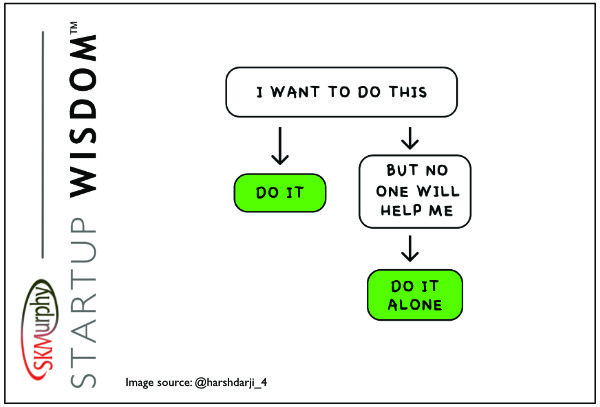Some tips for getting started today that will make it easier for you to find a cofounder and make your startup more attractive when you do.
What To Do Before You Find a Cofounder
I really like a flowchart Harsh Darji (@harshdarji_4) shared at the 7:40 mark during his “How to Innovate Using Visual Thinking” briefing since it applies to many entrepreneurial endeavors. In particular finding a cofounder.
I have a couple of observations.
It is not a compelling pitch to potential cofounders if you say, “I can’t get started without you,” which might imply that you are helpless without that person. Instead, it would be much better to say, “I’ve gotten started and here’s what I’ve accomplished.”
If you are a technical founder looking for someone who will do outreach, here are a few things to consider.
The first step you can do is to take your ideas and talk to friends or friends of friends. There’s a great book called The Mom Test, which gives you several tips and pitfalls to avoid in that process. Read it and talk to people that know you.
The second step is to tell your origin story. What gave your idea? What set of observations and experiences led you to the need for the product? Just structuring prior experiences, organizing them, and telling a coherent story is valuable. Then, taking that story and talking to friends is a great way to get feedback. Talking to friends of friends is better. And if you can find a way to talk to strangers, even better. You don’t need to try and sell. Instead, you can talk about the problem and verify that other people feel that it’s a problem and feel it’s a problem they would spend money on.
The third step is to figure out where prospects are hanging out. Then join forums and communities they’re members of and start curating comments, remarks, and questions relevant to your product.
If you have a business focus and are looking for a technical founder, here are some things you might consider:
On the non-technical side, on the sales and marketing side, I’m assuming you’ve done everything we told the technical people to do. There are a wealth of no-code options that you can use. There are things like Bubble.
You can also start with content because content marketing solves the same problem as your product. For example, you can develop helpful checklists, gather data, buyer guides, or service products. These all help solve the same problem, show proof of need, and your ability to help buyers. In addition, it demonstrates your ability to close deals if you can get paid for providing some assistance or some level of content.
You can often take existing products and create customizations, extensions, add-ons, and content templates that help make them more applicable to the particular problem you’re trying to solve. The experience of selling an alternative you’ve customized is an advance towards trying to sell your product.
We see this evolution in an expertise-based product where you develop expertise on the problem and find content that helps customers solve that problem. Then, you find add-ons, customized integrations, and templates that help solve that problem, and then you can move to a standalone tool. This progression ensures a solid understanding of product requirements when you finally look for folks to help you craft your platform and solution.
Related Blog Posts
- “Harsh Darji: “How to Innovate Using Visual Thinking“
- Derek Sivers: “Start Now, No Funding Needed.”
- Finding a Co-Founder: Compromise and Get Started
- Finding a Co-Founder: 3 Months is a Long Time
- Finding a Co-Founder: Compromise and Get Started
- Finding a Co-Founder: 3 Months is a Long Time
- Three Tips for Minimizing Misunderstandings Among Co-Founders
- A Cofounder Commitment is Long Term: an Informed Decision Takes Time
- Q: What Lessons Should I Draw From A Painful Cofounder Experience?

